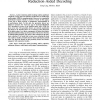Free Online Productivity Tools
i2Speak
i2Symbol
i2OCR
iTex2Img
iWeb2Print
iWeb2Shot
i2Type
iPdf2Split
iPdf2Merge
i2Bopomofo
i2Arabic
i2Style
i2Image
i2PDF
iLatex2Rtf
Sci2ools
CORR
2010
Springer
2010
Springer
On the Proximity Factors of Lattice Reduction-Aided Decoding
Lattice reduction-aided decoding enables significant complexity saving and near-optimum performance in multi-input multi-output (MIMO) communications. However, its remarkable performance largely remains a mystery to date. In this paper, a first step is taken towards a quantitative understanding of its performance limit. To this aim, the proximity factors are defined to measure the worst-case gap to maximum-likelihood (ML) decoding in terms of the signal-to-noise ratio (SNR) for given error rate. The proximity factors are derived analytically and found to be bounded above by a function of the dimension of the lattice alone. As a direct consequence, it follows that lattice reduction-aided decoding can always achieve full receive diversity of MIMO fading channels. The study is then extended to the dualbasis reduction. It is found that in some cases reducing the dual can result in smaller proximity factors than reducing the primal basis. The theoretic bounds on the proximity factors are fu...
| Added | 09 Dec 2010 |
| Updated | 09 Dec 2010 |
| Type | Journal |
| Year | 2010 |
| Where | CORR |
| Authors | Cong Ling |
Comments (0)

